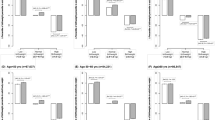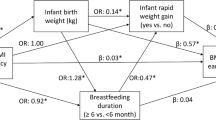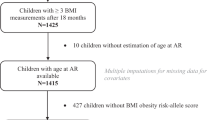Abstract
Background/objective
Children BMI is a longitudinal phenotype, developing through interplays between genetic and environmental factors. Whilst childhood obesity is escalating, we require a better understanding of its early origins and variation across generations to prevent it.
Subjects/methods
We designed a cross-cohort study including 12,040 Finnish children from the Northern Finland Birth Cohorts 1966 and 1986 (NFBC1966 and NFBC1986) born before or at the start of the obesity epidemic. We used group-based trajectory modelling to identify BMI trajectories from 2 to 20 years. We subsequently tested their associations with early determinants (mother and child) and the possible difference between generations, adjusted for relevant biological and socioeconomic confounders.
Results
We identified four BMI trajectories, ‘stable-low’ (34.8%), ‘normal’ (44.0%), ‘stable-high’ (17.5%) and ‘early-increase’ (3.7%). The ‘early-increase’ trajectory represented the highest risk for obesity. We analysed a dose-response association of maternal pre-pregnancy BMI and smoking with BMI trajectories. The directions of effect were consistent across generations and the effect sizes tended to increase from earlier generation to later. Respectively for NFBC1966 and NFBC1986, the adjusted risk ratios of being in the early-increase group were 1.08 (1.06–1.10) and 1.12 (1.09–1.15) per unit of pre-pregnancy BMI and 1.44 (1.05–1.96) and 1.48 (1.17–1.87) in offspring of smoking mothers compared to non-smokers. We observed similar relations with infant factors including birthweight for gestational age and peak weight velocity. In contrast, the age at adiposity peak in infancy was associated with the BMI trajectories in NFBC1966 but did not replicate in NFBC1986.
Conclusions
Exposures to adverse maternal predictors were associated with a higher risk obesity trajectory and were consistent across generations. However, we found a discordant association for the timing of adiposity peak over a 20-year period. This suggests the role of residual environmental factors, such as nutrition, and warrants additional research to understand the underlying gene–environment interplay.
This is a preview of subscription content, access via your institution
Access options
Subscribe to this journal
Receive 12 print issues and online access
$259.00 per year
only $21.58 per issue
Buy this article
- Purchase on Springer Link
- Instant access to full article PDF
Prices may be subject to local taxes which are calculated during checkout



Similar content being viewed by others
Data availability
Data are available from the Northern Finland Birth Cohort (NFBC) for researchers who meet the criteria for accessing confidential data. Please, contact NFBC project centre (NFBCprojectcenter@oulu.fi) and visit the cohort website (www.oulu.fi/nfbc) for more information.
References
WHO. Obesity and overweight, Fact sheet. 2018. https://www.who.int/news-room/fact-sheets/detail/obesity-and-overweight.
NCD Risk Factor Collaboration (NCD-RisC). Worldwide trends in body-mass index, underweight, overweight, and obesity from 1975 to 2016: a pooled analysis of 2416 population-based measurement studies in 128.9 million children, adolescents, and adults. Lancet. 2017;390:2627–42.
Bradfield JP, Vogelezang S, Felix JF, Chesi A, Helgeland O, Horikoshi M, et al. A trans-ancestral meta-analysis of genome-wide association studies reveals loci associated with childhood obesity. Hum Mol Genet. 2019;28:3327–38.
Felix JF, Bradfield JP, Monnereau C, van der Valk RJ, Stergiakouli E, Chesi A, et al. Genome-wide association analysis identifies three new susceptibility loci for childhood body mass index. Hum Mol Genet. 2016;25:389–403.
Bond TA, Karhunen V, Wielscher M, Auvinen J, Mannikko M, Keinanen-Kiukaanniemi S, et al. Exploring the role of genetic confounding in the association between maternal and offspring body mass index: evidence from three birth cohorts. Int J Epidemiol. 2020;49:233–43.
Araujo J, Severo M, Barros H, Mishra GD, Guimaraes JT, Ramos E. Developmental trajectories of adiposity from birth until early adulthood and association with cardiometabolic risk factors. Int J Obes. 2015;39:1443–9.
Rolland-Cachera MF, Deheeger M, Bellisle F, Sempe M, Guilloud-Bataille M, Patois E. Adiposity rebound in children: a simple indicator for predicting obesity. Am J Clin Nutr. 1984;39:129–35.
Baird J, Fisher D, Lucas P, Kleijnen J, Roberts H, Law C. Being big or growing fast: systematic review of size and growth in infancy and later obesity. BMJ. 2005;331:929.
Jung T, Wickrama KAS. An introduction to latent class growth analysis and growth mixture modeling. Soc Personal Psychol Compass. 2008;2:302–17.
Daniel N. Group-based modeling of development. US: Harvard University Press; 2005.
Marcoulides GA, Schumacker RE. (Eds). Latent variable mixture modeling. In: New developments and techniques in structural equation modeling: Psychology Press; 2001.
Ziyab AH, Karmaus W, Kurukulaaratchy RJ, Zhang H, Arshad SH. Developmental trajectories of Body Mass Index from infancy to 18 years of age: prenatal determinants and health consequences. J Epidemiol Community Health. 2014;68:934–41.
Stuart B, Panico L. Early-childhood BMI trajectories: evidence from a prospective, nationally representative British cohort study. Nutr Diabetes. 2016;6:e198.
Peneau S, Giudici KV, Gusto G, Goxe D, Lantieri O, Hercberg S, et al. Growth trajectories of Body Mass Index during childhood: associated factors and health outcome at adulthood. J Pediatr. 2017;186:64–71.
Tu AW, Masse LC, Lear SA, Gotay CC, Richardson CG. Body mass index trajectories from ages 1 to 20: results from two nationally representative canadian longitudinal cohorts. Obesity. 2015;23:1703–11.
Voerman E, Santos S, Patro Golab B, Amiano P, Ballester F, Barros H, et al. Maternal body mass index, gestational weight gain, and the risk of overweight and obesity across childhood: an individual participant data meta-analysis. PLoS Med. 2019;16:e1002744.
Gaillard R, Wright J, Jaddoe VWV. Lifestyle intervention strategies in early life to improve pregnancy outcomes and long-term health of offspring: a narrative review. J Dev Orig Health Dis. 2019;10:314–21.
de Onis M, Onyango A, Borghi E, Siyam A, Blossner M, Lutter C, et al. Worldwide implementation of the WHO Child Growth Standards. Public Health Nutr. 2012;15:1603–10.
Sovio U, Kaakinen M, Tzoulaki I, Das S, Ruokonen A, Pouta A, et al. How do changes in body mass index in infancy and childhood associate with cardiometabolic profile in adulthood? Findings from the Northern Finland Birth Cohort 1966 Study. Int J Obes. 2014;38:53–9.
Tzoulaki I, Sovio U, Pillas D, Hartikainen AL, Pouta A, Laitinen J, et al. Relation of immediate postnatal growth with obesity and related metabolic risk factors in adulthood: the northern Finland birth cohort 1966 study. Am J Epidemiol. 2010;171:989–98.
Berkey CS, Reed RB. A model for describing normal and abnormal growth in early childhood. Hum Biol. 1987;59:973–87.
Nagin D, Tremblay RE. Trajectories of boys’ physical aggression, opposition, and hyperactivity on the path to physically violent and nonviolent juvenile delinquency. Child Dev. 1999;70:1181–96.
Ostbye T, Malhotra R, Landerman LR. Body mass trajectories through adulthood: results from the National Longitudinal Survey of Youth 1979 Cohort (1981-2006). Int J Epidemiol. 2011;40:240–50.
Hejazi S, Dahinten VS, Marshall SK, Ratner PA. Developmental pathways leading to obesity in childhood. Health Rep. 2009;20:63–9.
Montazeri P, Vrijheid M, Martinez D, Basterrechea M, Fernandez-Somoano A, Guxens M, et al. Maternal metabolic health parameters during pregnancy in relation to early childhood BMI trajectories. Obesity. 2018;26:588–96.
Rugholm S, Baker JL, Olsen LW, Schack-Nielsen L, Bua J, Sorensen TI. Stability of the association between birth weight and childhood overweight during the development of the obesity epidemic. Obes Res. 2005;13:2187–94.
Graversen L, Sorensen TI, Petersen L, Sovio U, Kaakinen M, Sandbaek A, et al. Stability of the associations between early life risk indicators and adolescent overweight over the evolving obesity epidemic. PLoS ONE. 2014;9:e95314.
Tyrrell J, Richmond RC, Palmer TM, Feenstra B, Rangarajan J, Metrustry S, et al. Genetic evidence for causal relationships between maternal obesity-related traits and birth weight. JAMA. 2016;315:1129–40.
Richmond RC, Timpson NJ, Felix JF, Palmer T, Gaillard R, McMahon G, et al. Using genetic variation to explore the causal effect of maternal pregnancy adiposity on future offspring adiposity: a Mendelian Randomisation Study. PLoS Med. 2017;14:e1002221.
Couto Alves A, De Silva N, Maneka G, Karhunen V, Sovio U, Das S, et al. GWAS on longitudinal growth traits reveals different genetic factors influencing infant, child, and adult BMI. Sci Adv. 2019;5:eaaw3095.
Silverwood RJ, De Stavola BL, Cole TJ, Leon DA. BMI peak in infancy as a predictor for later BMI in the Uppsala Family Study. Int J Obesity. 2009;33:929–37.
Kruithof CJ, Gishti O, Hofman A, Gaillard R, Jaddoe VW. Infant weight growth velocity patterns and general and abdominal adiposity in school-age children. The Generation R Study. Eur J Clin Nutr. 2016;70:1144–50.
Helgeland O, Vaudel M, Juliusson PB, Lingaas Holmen O, Juodakis J, Bacelis J, et al. Genome-wide association study reveals dynamic role of genetic variation in infant and early childhood growth. Nat Commun. 2019;10:4448–0.
Johnson W, Soloway LE, Erickson D, Choh AC, Lee M, Chumlea WC, et al. A changing pattern of childhood BMI growth during the 20th century: 70 y of data from the Fels Longitudinal Study. Am J Clin Nutr. 2012;95:1136–43.
Hultin H, Opas R, Sarna S. Breast feeding of babies in Finland in the seventies. Katilolehti. 1974;79:365.
Uusitalo L, Nyberg H, Pelkonen M, Sarlio-Lähteenkorva S, Hakulinen-Viitanen T, Virtanen S. Imeväisikäisten ruoki nta Suomessa vuonna 2010. THL. Report 8/2012.
Wu YY, Lye S, Briollais L. The role of early life growth development, the FTO gene and exclusive breastfeeding on child BMI trajectories. Int J Epidemiol. 2017;46:1512–22.
Ejlerskov KT, Christensen LB, Ritz C, Jensen SM, Molgaard C, Michaelsen KF. The impact of early growth patterns and infant feeding on body composition at 3 years of age. Br J Nutr. 2015;114:316–27.
Nagin DS, Odgers CL. Group-based trajectory modeling in clinical research. Annu Rev Clin Psychol. 2010;6:109–38.
Acknowledgements
We thank all cohort members and researchers who participated in the Northern Finland Birth Cohorts 1966 and 1986. We also wish to acknowledge the work of the NFBC project centre.
Funding
This work was supported by European Union’s Horizon 2020 research and innovation programme [DYNAHEALTH 633595, LIFECYCLE 733206, EUCANCONNECT 824989, LongITools 874739, EarlyCause 848458], Academy of Finland [EGEA 285547] and the JPI-HDHL programme [PREcise—MRC-UK P75416]. The funding sources had no influence in the study design, collection, analysis, interpretation of data, writing of the report and in the decision to submit the article.
Author information
Authors and Affiliations
Corresponding author
Ethics declarations
Conflict of interest
The authors declare that they have no conflict of interest.
Ethical approval
All procedures performed were in accordance with the 1964 Helsinki declaration. The Ethics Committee of the Northern Ostrobothnia Hospital District has approved the NFBC1966 and NFBC1986 studies.
Informed consent
Mothers gave their informed consent in the beginning of the NFBC1966 and 1986 data collections. Written informed consent has been obtained from the cohort participants in the 31- and 46-year data collections.
Additional information
Publisher’s note Springer Nature remains neutral with regard to jurisdictional claims in published maps and institutional affiliations.
Supplementary information
Rights and permissions
About this article
Cite this article
Nedelec, R., Miettunen, J., Männikkö, M. et al. Maternal and infant prediction of the child BMI trajectories; studies across two generations of Northern Finland birth cohorts. Int J Obes 45, 404–414 (2021). https://doi.org/10.1038/s41366-020-00695-0
Received:
Revised:
Accepted:
Published:
Issue Date:
DOI: https://doi.org/10.1038/s41366-020-00695-0
This article is cited by
-
The associations of maternal and paternal obesity with latent patterns of offspring BMI development between 7 and 17 years of age: pooled analyses of cohorts born in 1958 and 2001 in the United Kingdom
International Journal of Obesity (2023)
-
Changes over time in latent patterns of childhood-to-adulthood BMI development in Great Britain: evidence from three cohorts born in 1946, 1958, and 1970
BMC Medicine (2021)



